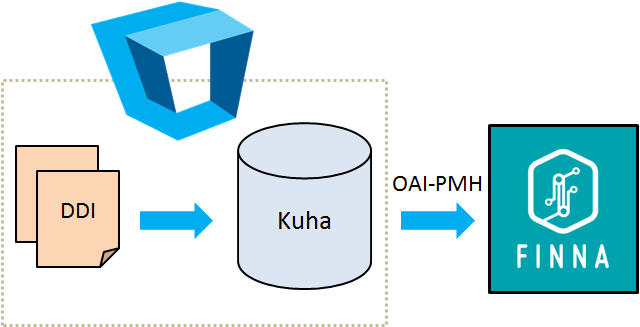Arttu Ylä-Outinen
OAI-PMH Server Kuha Displays FSD Study Descriptions in Finna
At the beginning of September, the study descriptions of data archived at the FSD became searchable in the Finna information search service, which brings together the collections of Finnish archives, libraries and museums. The metadata are transferred by using the Open Archives Initiative Protocol for Metadata Harvesting (OAI-PMH). In order to transfer the metadata, a separate OAI-PMH server, Kuha, was developed at the FSD.
The OAI-PMH is a protocol that allows archives to expose metadata to service providers. Using the metadata harvested from archives, service providers offer end users different services, such as search engines or catalogues.
The current version of the protocol, 2.0, was published in 2002. Over the years, it has established itself as an important means of delivering metadata and continues to be widely used. Now the FSD also offers its metadata by using the OAI-PMH.
Software used by the FSD
Development work for the FSD’s own OAI-PMH server began in February 2014. Despite the sweltering summer, developing the interface and integrating it with Finna progressed swiftly. The interface was completed in August and the metadata have been visible in Finna from the beginning of September. It was decided that the Kuha software itself be also published. It is available open-source on GitHub.
Different formats for delivering metadata
OAI-PMH servers can expose metadata to service providers in several different formats. Dublin Core and EAD (Encoded Archival Description) were selected as the supported formats for the archive’s OAI-PMH service. Kuha server generates these formats from the FSD’s DDI-format study descriptions.

Metadata are transferred to Finna by using OAI-PMH protocol. To enable transferring, we developed our own OAI-PMH server, Kuha.
Dublin Core is a simple format that defines only 15 metadata fields. However, it is a required format in OAI-PMH. This ensures that archives and service providers use at least one mutual format.
The other format used by the FSD, EAD, is used to deliver study descriptions to Finna. EAD allows for a more detailed representation of metadata than Dublin Core. For example, datasets can be displayed as arranged hierarchically into data series.
Visibility for data
The main purpose of the FSD’s OAI-PMH service is to deliver metadata to Finna, which combines all the archives, libraries and museums in Finland in a single search. A user who finds an interesting research article can find the data used for it in the same place. As a result, the valuable collections of the FSD can be found by an even wider audience than before. Along with our metadata, a completely new content type, research data, was added to Finna.
Other potential future users of the OAI-PMH service could be, for instance, the Finnish National Research Data Initiative’s (ATT) Etsin Research Data Finder and CESSDA’s European-wide data catalogue. Using the FSD’s OAI-PMH service is by no means limited to the organisations mentioned above, as anyone can harvest the FSD metadata for their service.